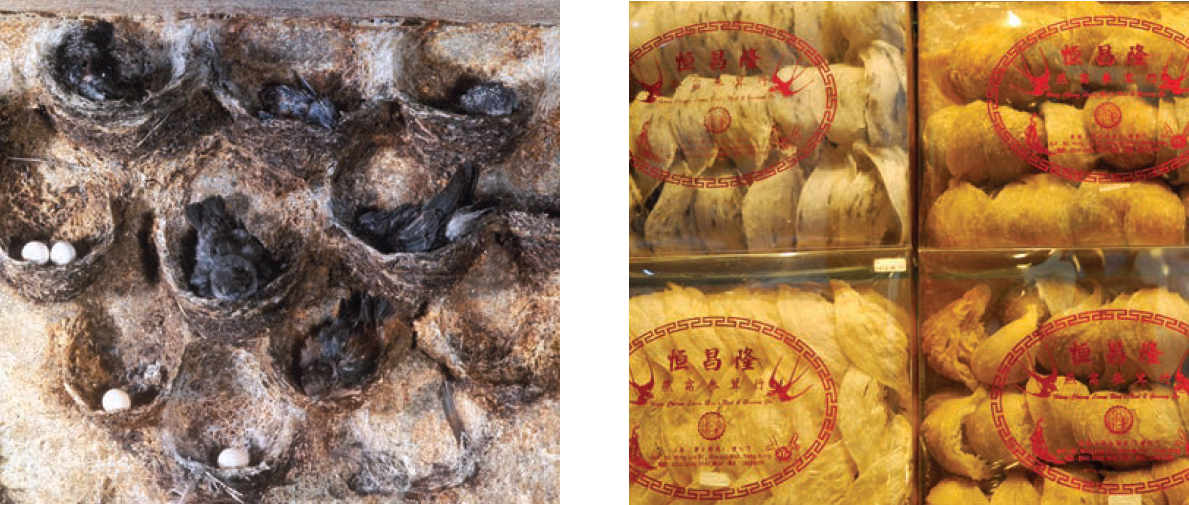
The over-exploitation of Edible-nest Swiftlet colonies shows how quickly the demands of human free trade can deplete unique wild populations of bird species.
48 : Swiftlet’s nest
1922

The over-exploitation of Edible-nest Swiftlet colonies shows how quickly the demands of human free trade can deplete unique wild populations of bird species.
Among the multitude of interesting ingredients in Oriental cookery are the nests of a few species of cave swiftlet, opaque cups of congealed saliva that are among the most expensive animal-derived delicacies. This ‘caviar of the east’ has been used in Chinese cookery for at least 400 years, and when dissolved in water makes a glutinous soup alleged to improve digestion, improve the immune system and – inevitably – act as an aphrodisiac.
The nests, most commonly of the Edible-nest Swiftlet, contain the same ovotransferrin protein as egg white, and are traditionally collected from the walls of limestone caves in Borneo. However, the lucrative trade has meant that many are now harvested from specially built reinforced concrete nesting houses in more widespread locations in South-East Asia, and the swiftlets’ colonial presence has led to boom towns growing where subsistence villages once stood.
Who could begrudge local people lifting themselves out of poverty by exploiting a remunerative natural resource to be found in their native towns? It was an easily harvested and readily prepared commodity that commanded high enough prices to be viewed as a bourgeois indulgence during the Chairman Mao era, and now a new generation of Chinese nouveau riche are keen to import it at a premium.
Perhaps conservationists could begrudge that kind of tradition. Far from being a sustainable local practice, it had a significant impact in some places. Colonies in the Andaman Islands, for example, have been significantly over-exploited, causing the locally endemic subspecies of Edible-nest Swiftlet to be listed by the International Union for the Conservation of Nature as Critically Endangered.
The temptation to over-collect or harvest too early for impoverished islanders with little other source of income often proves too much hindrance for the introduction of sustainable harvesting methods. The Indian government which administers the Andamans has made Edible-nest Swiftlet one of its most highly protected birds, but the difficulties of guarding remote nest sites and the fact that collectors are well rewarded enough to even risk death means that the population of the birds has barely recovered over the last decade.
Overall, there is a substantial export trade of swiftlet nests mostly through the hub of Hong Kong to countries such as Japan, South Korea, Taiwan, Singapore, Canada and the USA, much of which is legal as the major species are listed as Least Concern on the worldwide criteria used by the IUCN and BirdLife International.
But aspects of the Edible-nest Swiftlet case encapsulate many of the problems of modern conservation, with their geographical, cultural, taxonomic and economic reach. Though the species is widespread and common in places, exploitation of its nests has caused has caused a decrease in numbers, rather marked in some genetically unique populations, and international legislation is incomplete, has been partly ignored or cannot be enforced where it is most needed.
Historically, the exploitation of bird species, from encouraging House Sparrows to breed for easily accessible eggs and chicks on the one hand to the profligate hunting of dozens of colourful or exotic species merely for their plumes on the other, has actually inspired modern bird conservation as we know it. And this tricky balance, constantly buffeted by human changes, will continue as ecosystems and biodiversity are now discussed in pseudo-or actual economic terms and contexts.
The human exploitation of birds on an international scale, symbolised here by the tiny nest of Collocalia fuciphaga, needed a cross-border organisation to try to prevent the loss of global avian biodiversity and reach beyond the limits of country-specific organisations. It was to lobby internationally in this way that American ornithologists T Gilbert Pearson and J T Delacour formed the International Council for Bird Preservation in 1922, this organisation transforming into BirdLife International in 1993. It exists to foster co-operation between bird preservation organisations throughout the world, bolstering their efforts, pooling resources and expertise, and – most importantly of all – speaking out globally on behalf of birds with a single voice.